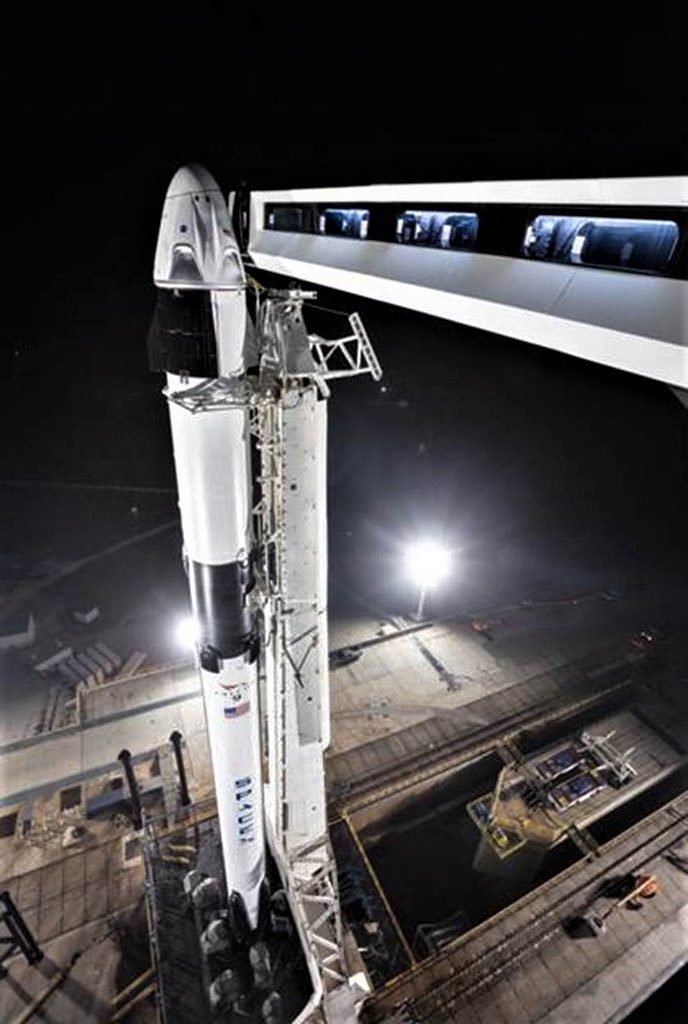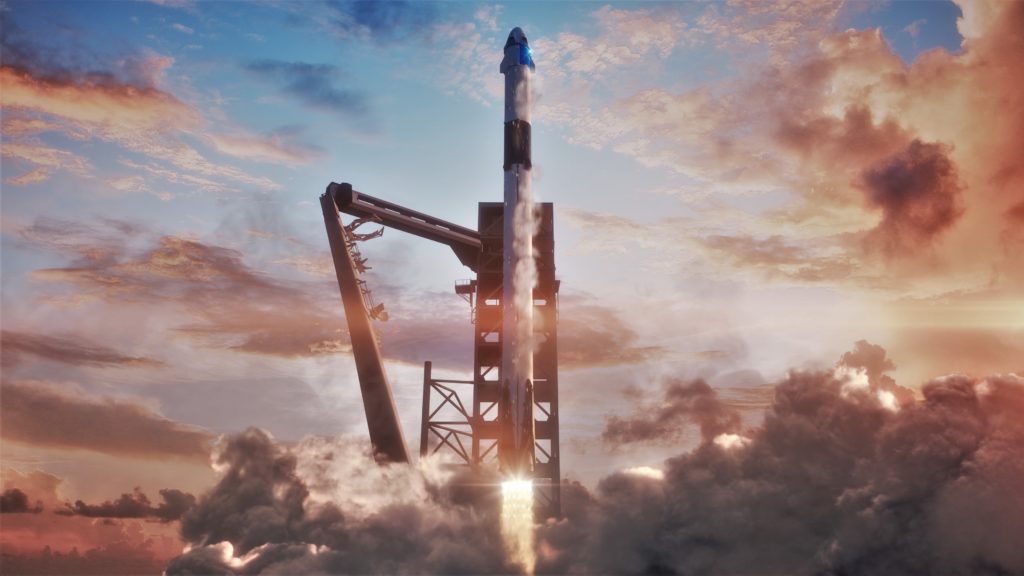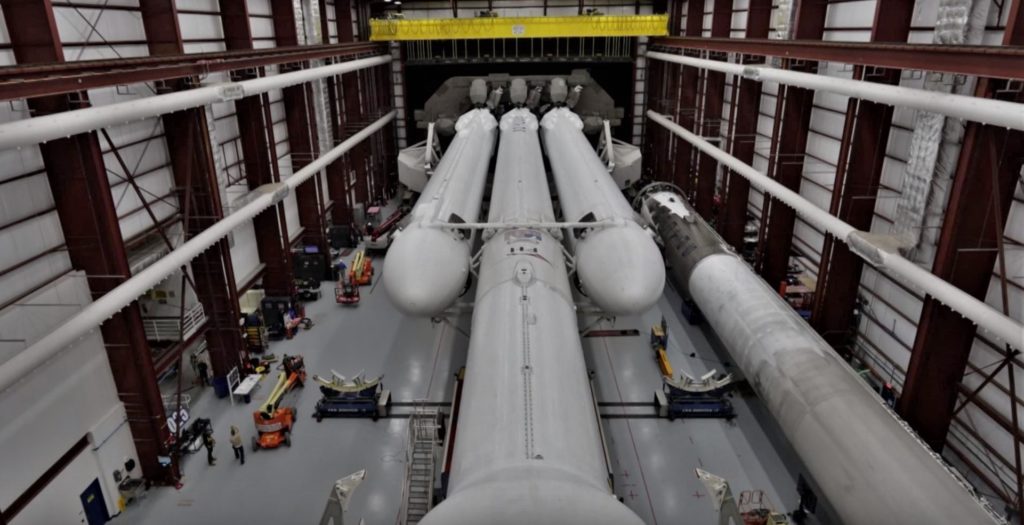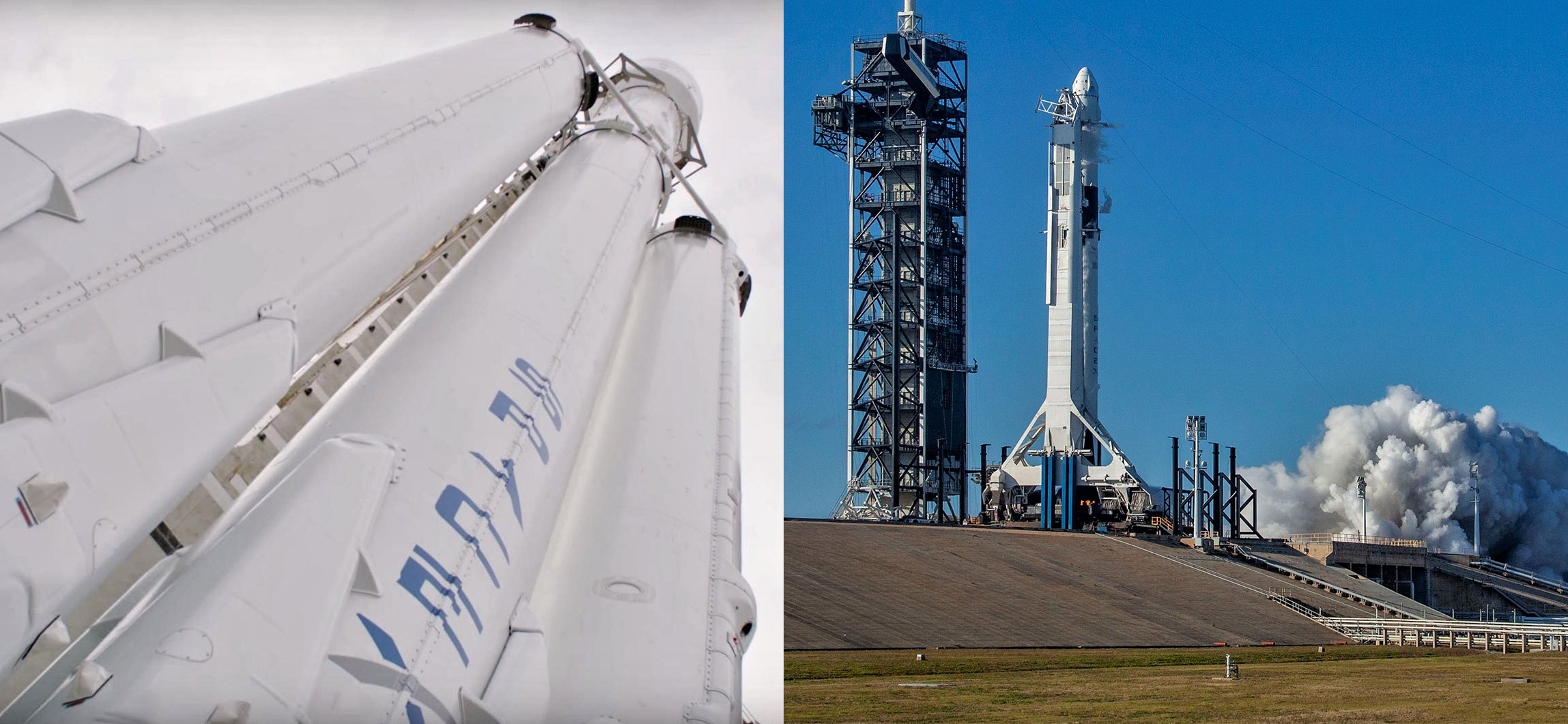

SpaceX
SpaceX’s Crew Dragon launch moves to March, risking Falcon Heavy delays
The planning date for the launch debut of SpaceX’s Crew Dragon spacecraft has been pushed to no earlier than (NET) March 2019 per sources familiar with the matter, potentially creating a direct schedule conflict with the company’s planned operational debut of Falcon Heavy, also NET March 2019.
At the same time as delays to the Commercial Crew Program continue to increase the odds that NASA will lose assured access to the International Space Station (ISS) in 2020, both of SpaceX’s critical missions are entirely dependent upon the support of its Kennedy Space Center-located Launch Complex 39A (Pad 39A), creating a logistical puzzle that will likely delay Falcon Heavy’s second launch until Crew Dragon is safely in orbit.
The latest updates that #SpaceX has made to LC-39A. They have made a lot of progress with the cladding in the last month. #Falcon9 #Space #Spaceflight #SpaceCoast #Florida #KSC @NASASpaceflight pic.twitter.com/sq76IKDc3K
— Tom (@Cygnusx112) February 2, 2019
As of the first week of December 2018, SpaceX was reportedly planning towards a mid-January 2019 launch debut for Crew Dragon. By the end of December, DM-1 was no earlier than the end of January. By the end of January, DM-1 had slipped to from late-February to NET March 2019. Put in slightly different terms, SpaceX’s Crew Dragon launch debut has been more or less indefinitely postponed for the last two months, with planning dates being pushed back at roughly the same pace as the passage of time (i.e. a day’s delay every day).
Admittedly, DM’s apparently indefinite postponement may well be – and probably is – more of an artifact than a sign of any monolithic cause. While the US government’s longest-ever shutdown (35 days) undoubtedly delayed a major proportion of mission-critical work having to do with extensive NASA reviews of SpaceX and Crew Dragon’s launch readiness (known as Readiness Reviews), much of the 60+ day DM-1 delay can probably be attributed to the complexity of the tasks at hand. Being as it is the first time SpaceX has ever attempted a launch directly related to human spaceflight, as well as the first time NASA has been back at the helm (more or less) of US astronaut launch endeavors in more than 7.5 years, significant delays should come as no surprise regardless of how disappointing they may be.
- Crew Dragon and its crew-rated Falcon 9 went vertical at a launch pad (Pad 39A) for the first time ever on January 4th. (SpaceX)
- The whole shebang. (SpaceX)
- The integrated DM-1 Crew Dragon ‘stack’ rolled out to Pad 39A for the first time in the first few days of 2019. (SpaceX)
- A render of Crew Dragon launching atop Falcon 9. (SpaceX)
The most consequential aspect of DM-1’s two-month (at least) delay will likely be the myriad ways it feeds into delays of SpaceX’s in-flight abort (IFA) test and first crewed launch (DM-2), and thus’s NASA’s ability to once again independently launch US astronauts. Given that SpaceX’s DM-2 is expected to occur around six months after DM-1 and that the final certification of Crew Dragon for official astronaut launches will likely take another 2-3 months, these delays – barring heroics or program modifications – are pushing NASA dangerously close to the edge of losing assured US access to the International Space Station (ISS).
According to a July 2018 report, the Government Accountability Office (GAO) analyzed the Commercial Crew Program and NASA’s human spaceflight program more generally and concluded that NASA would lose assured access to the ISS in November 2019 if Boeing and SpaceX continued to suffer delays and were unable to reach certification status by then. This comes as a result of NASA’s reliance on Russian Soyuz launches for access both to and from the ISS, launch and return service contracts which have no replacements (aside from SpaceX and Boeing). While GAO noted that NASA could likely delay that loss of assured access until January 2020, even that might be pushing it if SpaceX’s DM-1 delay continues much further.
“[While NASA is working on potential solutions, it] has not yet developed a contingency plan to address the potential gaps that [future delays in Boeing and SpaceX schedules] could have on U.S. access to the ISS after 2019.” – GAO, July 2018
Prior to DM-1’s delay from NET January to NET March 2019, SpaceX was targeting an In-Flight Abort test roughly three months after DM-1 (it will reuse DM-1’s Crew Dragon capsule), DM-2 six months after DM-1 (NET June 2019), and NASA certification and the first operational astronaut launch (PCM-1) as few as two months after DM-2 (August 2019). It’s reasonable to assume that delays to DM-1 will impact subsequent Crew Dragon launches roughly 1:1, as DM-2 and its many associated reviews hinge directly on DM-1, while the same relationship also exists between PCM-1 and DM-2. As a result, Crew Dragon’s two-month delay probably means that SpaceX’s NASA certification will occur no earlier than October 2019, giving NASA no more than 90 days of buffer before the US presence on the ISS drops from around 50% (3 astronauts) to 0%.
An excellent view of #SpaceX Launch Complex 39A – better known as Pad 39A – from a February 4th Air National Guard (180th Fighter Wing) flyover. Of note, SpaceX has painted the FSS (tower) black and white and is in the process of installing transparent cladding. pic.twitter.com/DTiGWJk1D7
— Eric Ralph (@13ericralph31) February 5, 2019
Crew Dragon and Falcon Heavy walk into a bar…
The unexpected delays to Crew Dragon’s DM-1 launch debut are likely placing SpaceX in an awkward situation with respect to the operational launch debut of Falcon Heavy, meant to place the terminally delayed Arabsat 6A satellite into orbit no earlier than March 7th, 2019 (at the absolute earliest). DM-1 is also targeting a launch sometime in March, posing a significant problem: both Falcon Heavy and Crew Dragon can only launch from Pad 39A, while the on-site hangar simply doesn’t have the space to support schedule-critical Falcon Heavy prelaunch work (mainly booster integration and a static fire test) and no less critical Crew Dragon launch preparations simultaneously.
- SpaceX’s 39A hangar is massive but it would be a stretch to support Crew Dragon and Falcon Heavy simultaneously. (SpaceX)
- An impressive view of Crew Dragon (DM-1), Falcon 9 B1051, and its upper stage. (SpaceX)
Much like SpaceX’s inaugural Falcon Heavy rocket spent a month and a half fully integrated and more than two weeks in a static-fire limbo (albeit due to one-of-a-kind circumstances) before its launch debut, SpaceX’s second Falcon Heavy rocket – comprised of three new Block 5 boosters and Heavy-specific hardware upgrades – is likely to take a good deal more time than a normal Falcon 9 for prelaunch processing. Almost all of that Heavy-specific testing depends on the rocket being integrated (i.e. all three boosters attached) for preflight fit and systems checks and a wet dress rehearsal (WDR) and/or static fire ignition test.
It’s entirely possible that SpaceX integration technicians are able to complete the process of swapping out Crew Dragon and Falcon 9, modifying the transport/erector (T/E), completing Falcon Heavy booster integration, and installing Falcon Heavy on the T/E quickly enough to allow for simultaneous DM-1 and Arabsat 6A processing. It’s also possible that an extremely elegant but risky alternative strategy could solve the logistical puzzle – as an example, SpaceX could roll Crew Dragon and Falcon 9 out to Pad 39A a week or more before launch to give Falcon Heavy enough space for full integration, whereby Falcon 9’s necessarily successful launch would clear the T/E and allow it to be rolled back into 39A’s hangar for Falcon Heavy installation.
Falcon Heavy at the Cape pic.twitter.com/hizfDVsU7X
— Elon Musk (@elonmusk) December 20, 2017
The most likely (and least risky) end result, however, is an indefinite delay for Falcon Heavy Flight 2, pending the successful launch of Crew Dragon. This is very much an instance where “wait and see” is the only route to solid answers, so wait and see we shall.
Check out Teslarati’s newsletters for prompt updates, on-the-ground perspectives, and unique glimpses of SpaceX’s rocket launch and recovery processes!
News
SpaceX launches Ax-4 mission to the ISS with international crew
The SpaceX Falcon 9 launched Axiom’s Ax-4 mission to ISS. Ax-4 crew will conduct 60+ science experiments during a 14-day stay on the ISS.
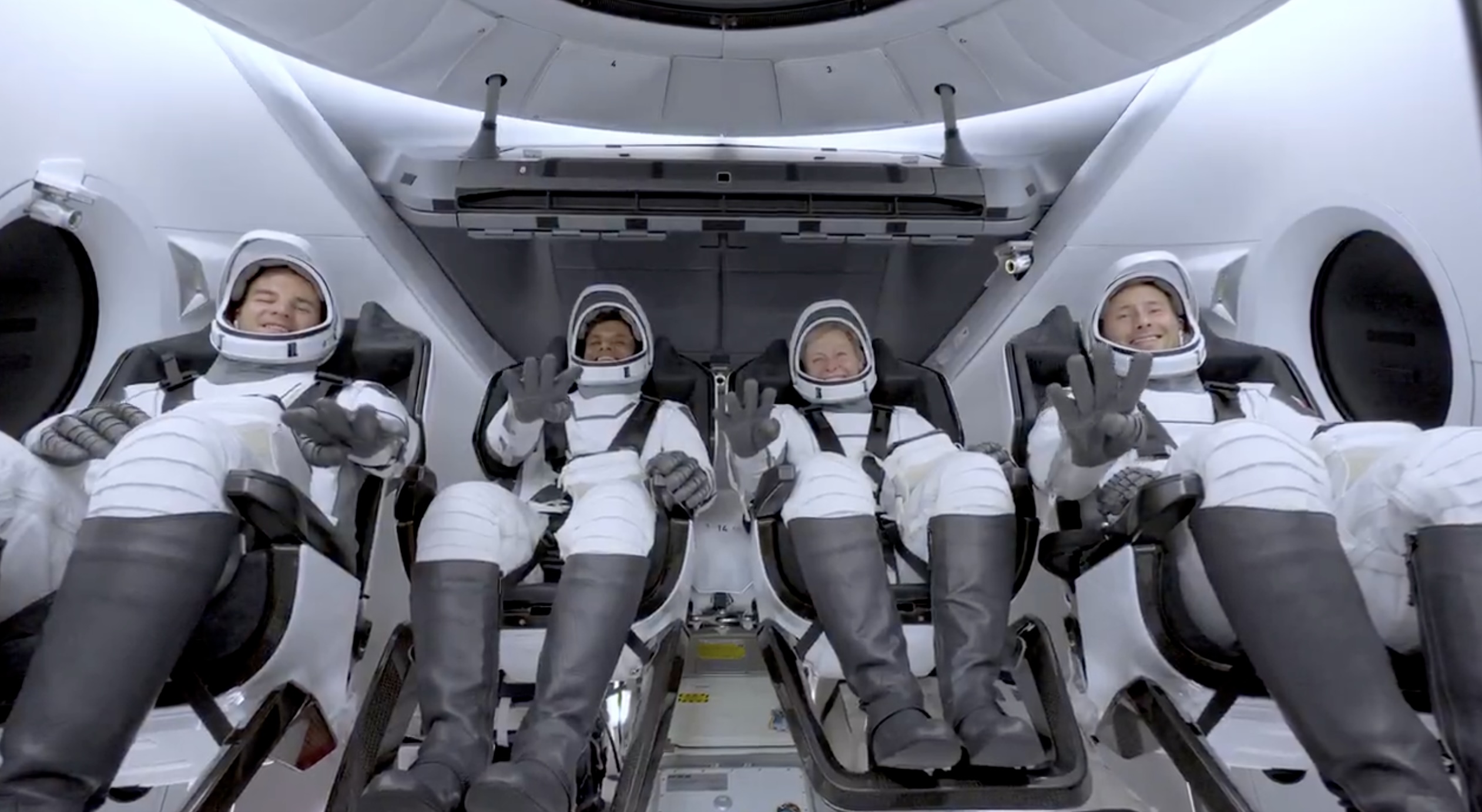
SpaceX launched the Falcon 9 rocket kickstarting Axiom Space’s Ax-4 mission to the International Space Station (ISS). Axiom’s Ax-4 mission is led by a historic international crew and lifted off from Kennedy Space Center’s Launch Complex 39A at 2:31 a.m. ET on June 25, 2025.
The Ax-4 crew is set to dock with the ISS around 7 a.m. ET on Thursday, June 26, 2025. Axiom Space, a Houston-based commercial space company, coordinated the mission with SpaceX for transportation and NASA for ISS access, with support from the European Space Agency and the astronauts’ governments.
The Ax-4 mission marks a milestone in global space collaboration. The Ax-4 crew, commanded by U.S. astronaut Peggy Whitson, includes Shubhanshu Shukla from India as the pilot, alongside mission specialists Sławosz Uznański-Wiśniewski from Poland and Tibor Kapu from Hungary.
“The trip marks the return to human spaceflight for those countries — their first government-sponsored flights in more than 40 years,” Axiom noted.
Shukla’s participation aligns with India’s Gaganyaan program planned for 2027. He is the first Indian astronaut to visit the ISS since Rakesh Sharma in 1984.
Axiom’s Ax-4 mission marks SpaceX’s 18th human spaceflight. The mission employs a Crew Dragon capsule atop a Falcon 9 rocket, designed with a launch escape system and “two-fault tolerant” for enhanced safety. The Axiom mission faced a few delays due to weather, a Falcon 9 leak, and an ISS Zvezda module leak investigation by NASA and Roscosmos before the recent successful launch.
As the crew prepares to execute its scientific objectives, SpaceX’s Ax-4 mission paves the way for a new era of inclusive space research, inspiring future generations and solidifying collaborative ties in the cosmos. During the Ax-4 crew’s 14-day stay in the ISS, the astronauts will conduct nearly 60 experiments.
“We’ll be conducting research that spans biology, material, and physical sciences as well as technology demonstrations,” said Whitson. “We’ll also be engaging with students around the world, sharing our experience and inspiring the next generation of explorers.”
SpaceX’s Ax-4 mission highlights Axiom’s role in advancing commercial spaceflight and fostering international partnerships. The mission strengthens global space exploration efforts by enabling historic spaceflight returns for India, Poland, and Hungary.
News
Starlink Cellular’s T-Mobile service to grow with third-party app data
From Oct 2025, T-Satellite will enable third-party apps in dead zones! WhatsApp, X, AccuWeather + more coming soon.

Starlink Cellular’s T-Mobile service will expand with third-party app data support starting in October, enhancing connectivity in cellular dead zones.
T-Mobile’s T-Satellite, supported by Starlink, launches officially on July 23. Following its launch, T-Mobile’s Starlink Cellular service will enable data access for third-party apps like WhatsApp, X, Google, Apple, AccuWeather, and AllTrails on October 1, 2025.
T-Mobile’s Starlink Cellular is currently in free beta. T-Satellite will add MMS support for Android phones on July 23, with iPhone support to follow. MMS support allows users to send images and audio clips alongside texts. By October, T-Mobile will extend emergency texting to all mobile users with compatible phones, beyond just T-Mobile customers, building on its existing 911 texting capability. The carrier also provides developer tools to help app makers integrate their software with T-Satellite’s data service, with plans to grow the supported app list.
T-Mobile announced these updates during an event celebrating an Ookla award naming it the best U.S. phone network, a remarkable turnaround from its last-place ranking a decade ago.
“We not only dream about going from worst to best, we actually do it. We’re a good two years ahead of Verizon and AT&T, and I believe that lead is going to grow,” said T-Mobile’s Chief Operating Officer Srini Gopalan.
T-Mobile unveiled two promotions for its Starlink Cellular services to attract new subscribers. A free DoorDash DashPass membership, valued at $10/month, will be included with popular plans like Experience Beyond and Experience More, offering reduced delivery and service fees. Meanwhile, the Easy Upgrade promotion targets Verizon customers by paying off their phone balances and providing flagship devices like the iPhone 16, Galaxy S25, or Pixel 9.
T-Mobile’s collaboration with SpaceX’s Starlink Cellular leverages orbiting satellites to deliver connectivity where traditional networks fail, particularly in remote areas. Supporting third-party apps underscores T-Mobile’s commitment to enhancing user experiences through innovative partnerships. As T-Satellite’s capabilities grow, including broader app integration and emergency access, T-Mobile is poised to strengthen its lead in the U.S. wireless market.
By combining Starlink’s satellite technology with strategic promotions, T-Mobile is redefining mobile connectivity. The upcoming third-party app data support and official T-Satellite launch mark a significant step toward seamless communication, positioning T-Mobile as a trailblazer in next-generation wireless services.
News
Starlink expansion into Vietnam targets the healthcare sector
Starlink aims to deliver reliable internet to Vietnam’s remote clinics, enabling telehealth and data sharing.

SpaceX’s Starlink expansion into Vietnam targets its healthcare sector. Through Starlink, SpaceX seeks to drive digital transformation in Vietnam.
On June 18, a SpaceX delegation met with Vietnam’s Ministry of Health (MoH) in Hanoi. SpaceX’s delegation was led by Andrew Matlock, Director of Enterprise Sales, and the discussions focused on enhancing connectivity for hospitals and clinics in Vietnam’s remote areas.
Deputy Minister of Health (MoH) Tran Van Thuan emphasized collaboration between SpaceX and Vietnam. Tran stated: “SpaceX should cooperate with the MoH to ensure all hospitals and clinics in remote areas are connected to the StarLink satellite system and share information, plans, and the issues discussed by members of the MoH. The ministry is also ready to provide information and send staff to work with the corporation.”
The MoH assigned its Department of Science, Technology, and Training to work with SpaceX. Starlink Vietnam will also receive support from Vietnam’s Department of International Cooperation. Starlink Vietnam’s agenda includes improving internet connectivity for remote healthcare facilities, developing digital infrastructure for health examinations and remote consultations, and enhancing operational systems.
Vietnam’s health sector is prioritizing IT and digital transformation, focusing on electronic health records, data centers, and remote medical services. However, challenges persist in deploying IT solutions in remote regions, prompting Vietnam to seek partnerships like SpaceX’s.
SpaceX’s Starlink has a proven track record in healthcare. In Rwanda, its services supported 40 health centers, earning praise for improving operations. Similarly, Starlink enabled remote consultations at the UAE’s Emirati field hospital in Gaza, streamlining communication for complex medical cases. These successes highlight Starlink’s potential to transform Vietnam’s healthcare landscape.
On May 20, SpaceX met with Vietnam’s Ministry of Industry and Trade, announcing a $1.5 billion investment to provide broadband internet, particularly in remote, border, and island areas. The first phase includes building 10-15 ground stations across the country. This infrastructure will support Starlink’s healthcare initiatives by ensuring reliable connectivity.
Starlink’s expansion in Vietnam aligns with the country’s push for digital transformation, as outlined by the MoH. By leveraging its satellite internet expertise, SpaceX aims to bridge connectivity gaps, enabling advanced healthcare services in underserved regions. This collaboration could redefine Vietnam’s healthcare infrastructure, positioning Starlink as a key player in the nation’s digital future.
-

 Elon Musk3 days ago
Elon Musk3 days agoTesla investors will be shocked by Jim Cramer’s latest assessment
-

 News1 week ago
News1 week agoTesla Robotaxi’s biggest challenge seems to be this one thing
-

 News2 weeks ago
News2 weeks agoTexas lawmakers urge Tesla to delay Austin robotaxi launch to September
-

 Elon Musk2 weeks ago
Elon Musk2 weeks agoFirst Look at Tesla’s Robotaxi App: features, design, and more
-

 Elon Musk2 weeks ago
Elon Musk2 weeks agoxAI’s Grok 3 partners with Oracle Cloud for corporate AI innovation
-

 News2 weeks ago
News2 weeks agoSpaceX and Elon Musk share insights on Starship Ship 36’s RUD
-

 News2 weeks ago
News2 weeks agoWatch Tesla’s first driverless public Robotaxi rides in Texas
-

 News2 weeks ago
News2 weeks agoTesla has started rolling out initial round of Robotaxi invites


